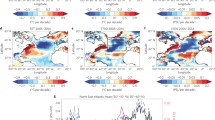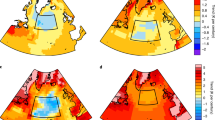Abstract
Part of the uncertainty in predictions by climate models results fromlimited knowledge of the stability of the thermohaline circulation ofthe ocean. Here we provide estimates of the response of pre-industrial surface climatevariables should the thermohalinecirculation in the Atlantic Ocean collapse. For this we have usedHadCM3, an ocean-atmosphere general circulation model that is run without fluxadjustments. In this model a temporary collapse was forced by applying a strong initial freshening to the top layers of the NorthAtlantic. In the first five decades after the collapse surface air temperatureresponse is dominated by cooling of much of the NorthernHemisphere (locally up to 8 °C, 1–2 °C on average) and weakwarming of theSouthern Hemisphere (locally up to 1 °C, 0.2 °C onaverage). Response is strongest around the North Atlantic but significant changesoccur over the entire globe and highlight rapidteleconnections.Precipitation is reduced over large parts of the Northern Hemisphere.A southward shift of the IntertropicalConvergence Zone over the Atlantic and eastern Pacific createschanges in precipitation that are particularly large in South America andAfrica. Colder and drier conditions in much of the Northern Hemisphere reducesoil moisture and net primary productivity of the terrestrial vegetation. Thisis only partlycompensated by more productivity in the Southern Hemisphere.The total global net primary productivity by the vegetation decreases by5%. It should be noted, however, that in this version of the model thevegetation distribution cannotchange, and atmospheric carbon levels are also fixed. After about 100 yearsthe model's thermohaline circulation has largelyrecovered, and most climatic anomalies disappear.
Similar content being viewed by others
References
Bryan, F.: 1986, 'High-Latitude Salinity Effects and Interhemispheric Thermohaline Circulations', Nature 323, 301-304.
Collins, M., Tett, S. F. B., and Cooper, C.: 2001, 'The Internal Climate Variability of HadCM3, a Version of the Hadley Centre Coupled Model without Flux Adjustments', Clim. Dyn. 17, 61-81.
Cox, P. M., Betts, R. A., Bunton, C. B., Essery, R. L. H., Rowntree, P. R., and Smith, J.: 1999, 'The Impact of New Land Surface Physics on the GCM Simulation of Climate and Climate Sensitivity', Clim. Dyn. 15, 183-203.
Cox, P. M., Betts, R. A., Jones, C. D., Spall, S. A., and Totterdell, I. J.: 2000, 'Acceleration of Global Warming Due to Carbon-Cycle Feedbacks in a Coupled Climate Model', Nature 408, 184-187.
Cubasch, U., Meehl, G. A., Boer. G. J., Stouffer, R. J., Dix, M., Noda, A., Senior, C. A., Raper, S. C. B., and Yap, K. S.: 2001, 'Projections of Future Climate Change', in Houghton, J. T., Ding, Y., Griggs, D. J., Noguer, M., van der Linden, P., Dai, X., Maskell, K., and Johnson, C. I. (eds.), Climate Change 2001: The Scientific Basis. Contribution of Working Group I to the Third Assessment Report of the Intergovernmental Panel on Climate Change, Cambridge University Press, pp. 525-582.
Ganachaud, A. and Wunsch, C.: 2000, 'Improved Estimates of Global Ocean Circulation, Heat Transport and Mixing from Hydrographic Data', Nature 408, 453-457.
Ganapolski, A., Petoukhov, V., Rahmstorf, S., Brovkin, V., Claussen, M., Eliseev, A., and Kubatzki, C.: 2001, 'CLIMBER-2: A Climate System Model of Intermediate Complexity. Part II: Model Sensitivity', Clim. Dyn. 17, 735-751.
Gordon, A. L.: 1986, 'Inter-Ocean Exchange of Thermocline Water', J. Geophys. Res. 91, 5037-5046.
Gordon, C., Cooper, C., Senior, C. A., Banks, H., Gregory, J. M., Johns, T. C., Mitchell, J. F. B., and Wood, R. A.: 2000, 'The Simulation of SST, Sea Ice Extents and Ocean Heat Transports in a Version of the Hadley Centre Coupled Model without Flux Adjustments', Clim. Dyn. 16, 147-168.
Hurrell, J.: 1995, 'Decadal Trends in the North Atlantic Oscillation: Regional Temperatures and Precipitation', Science 269, 676-679.
Johns, T. C., Gregory, J. M., Ingram, W. J., Johnson, C. E., Jones, A., Lowe, J. A., Mitchell, J. F. B., Roberts, D. L., Sexton, D. M. H., Stevenson, D. S., Tett, S. F. B., and Woodage, M. J.: 2001, Anthropogenic Climate Change for 1860 to 2100 Simulated with the HadCM3 Model under Updated Emissions Scenarios, Hadley Centre Technical Note 22, Hadley Centre, (URL http://www.metoffice.com/research/hadleycentre/pubs/HCTN/HCTN_22.pdf).
Jones, P., Horton, E., Folland, C., Hulme, M., Parker, D., and Basnett, T.: 1999, 'The Use of Indices to Identify Changes in Climatic Extremes', Clim. Change 42, 131-149.
Keller, K., Tan, K., Morel, F., and Braidford, D.: 2000, 'Preserving the Ocean Circulation: Implications for Climate Policy', Clim. Change 47, 17-43.
Latif, M., Roeckner, E., Mikolajewicz, U., and Voss, R.: 2000, 'Tropical Stabilisation of the Thermohaline Circulation in a Greenhouse Warming Simulation', J. Climate 13, 1809-1813.
Manabe, S. and Stouffer, R. J.: 1988, 'Two Stable Equilibria of a Coupled Ocean-Atmosphere Model', J. Climate 1, 841-866.
Manabe, S. and Stouffer, R. J.: 1994, 'Multiple Century Response of a Coupled Ocean-Atmosphere Model to an Increase of Atmospheric Carbon Dioxide', J. Climate 7, 5-23.
Manabe, S. and Stouffer, R. J.: 1995, 'Simulation of Abrupt Climatic Change Induced by Freshwater Input to the North Atlantic Oocean', Nature 378, 165-167.
Manabe, S. and Stouffer, R. J.: 1997, 'Coupled Ocean-Atmosphere Model Response to Freshwater Input: Comparison with Younger Dryas Event', Paleoceanography 12, 321-336.
Manabe, S. and Stouffer, R. J.: 1999, 'Are Two Modes of Thermohaline Circulation Stable?', Tellus 51A, 400-411.
Manley, G.: 1974, 'Central England Temperatures, Monthly Means 1659 to 1973', Quart. J. Roy. Meteorol. Soc. 79, 242-261.
Mastrandrea, M. and Schneider, S.: 2001, 'Integrated Assessment of Abrupt Climatic Changes', Climate Policy 1, 433-449.
Pardaens, A., Banks, H., Gregory, J., and Rowntree, P.: 2001, 'Freshwater Transports in HadCM3', Clim. Dyn., submitted.
Parker, D. E., Legg, T. P., and Folland, C. K.: 1992, 'A New Daily Central England Temperature Series', Int. J. Clim. 12, 317-342.
Peixoto, J. P. and Oort, A. H.: 1992, Physics of Climate, American Institute of Physics, New York.
Pope, V. D., Gallani, M. L., Rowntree, P. R., and Stratton, R. A.: 2000, 'The Impact of New Physical Parametrizations in the Hadley Centre Climate Model-HadAM3', Clim. Dyn. 16, 123-146.
Rahmstorf, S.: 1999, 'Shifting Seas in the Greenhouse?', Nature 399, 523-524.
Rahmstorf, S.: 2000, 'The Thermohaline Ocean Circulation: A System with Dangerous Thresholds?', Clim. Change 46, 247-256.
Rahmstorf, S. and Ganapolski, A.: 1999, 'Long-Term Global Warming Scenarios Computed with an Efficient Coupled Climate Model', Clim. Change 43, 353-367.
Sarmiento, J., Hughes, T., Stouffer, R., and Manabe, S.: 1998, 'Simulated Response of the Ocean Carbon Cycle to Anthropogenic Climate Warming', Nature 393, 245-249.
Sarnthein, M., Winn, K., Jung, S. J. A., Duplessy, J. C., and Labeyrie, L. et al.: 1994, 'Changes in East Atlantic Deep Water Circulation over the Last 30,000 Years: Eight Time Slice Reconstructions', Paleoceanography 9, 209-267.
Schiller, A., Mikolajewicz, U., and Voss, R.: 1997, 'The Stability of the Thermohaline Circulation in a Coupled Ocean-Atmosphere General Circulation Model', Clim. Dyn. 13, 325-347.
Stocker, T. and Schmittner, A.: 1997, 'Influence of CO2 Emission Rates on the Stability of the Thermohaline Circulation', Nature 388, 862-865.
Thorpe, R. B., Gregory, J. M., Johns, T. C., Wood, R. A., and Mitchell, J. F. B.: 2001, 'Mechanisms Determining the Atlantic Thermohaline Circulation Response to Greenhouse Gas Forcing in a Non-Flux-Adjusted Coupled Climate Model', J. Climate 14, 3102-3116.
Trenberth, K. E. and Caron, J. M.: 2001, 'Estimates of Meridional Atmosphere and Ocean Heat Transports', J. Climate 14, 3433-3443.
Vellinga, M., Wood, R. A., and Gregory, J. M.: 2002, 'Processes Governing the Recovery of a Perturbed Thermohaline Circulation in HadCM3', J. Climate 15, 764-780.
Wood, R. A., Keen, A. B., Mitchell, J. F. B., and Gregory, J. M.: 1999, 'Changing Spatial Structure of the Thermohaline Circulation in Response to Atmospheric CO2 Forcing in a Climate Model', Nature 399, 572-575.
Author information
Authors and Affiliations
Rights and permissions
About this article
Cite this article
Vellinga, M., Wood, R.A. Global Climatic Impacts of a Collapse of the Atlantic Thermohaline Circulation. Climatic Change 54, 251–267 (2002). https://doi.org/10.1023/A:1016168827653
Issue Date:
DOI: https://doi.org/10.1023/A:1016168827653




